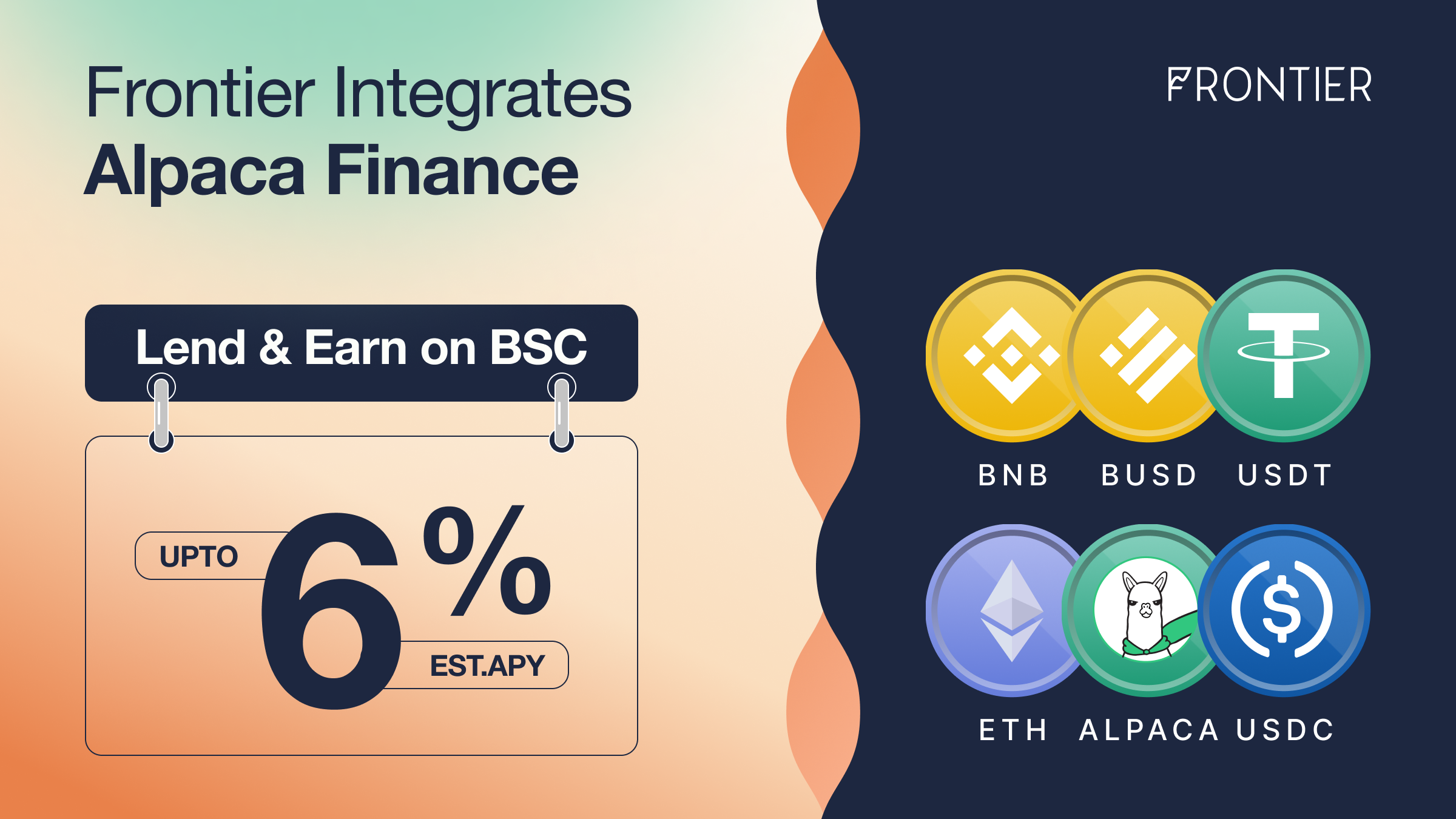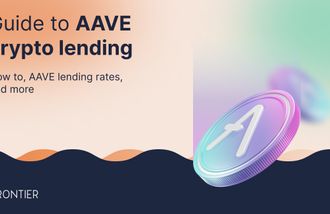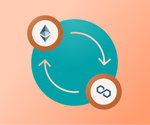

Aave, formerly known as ETHlend, is a DeFi protocol that provides its users with lending and borrowing services. In a simpler approach, Aave automatically solves the traditional lending and borrowing process by giving control to users. Here is a step-by-step guide on how to lend out your crypto assets on Aave using Frontier and earn interest.
The Aave protocol operates using a liquidity pool where liquidity providers- lenders that add liquidity are rewarded with incentives while borrowers borrow with an APR. The Aave's mechanism of the transaction is referred to as peer-to-pool-to-peer.
Built on the Ethereum network Aave formerly provided services with tokens in the Ethereum ecosystem. But its mode of operation now spans various blockchains including Avalanche, Fantom, and Harmony thereby making it a cross-chain lending and borrowing platform.
To maintain decentralization in the system, Aave's users with its native tokens or staked Aave can cast their vote through the governance option. The protocol has built a lot of added advantages around its native token- AAVE, both for borrowers and lenders such as a discount on transaction charges or gas fees, AAVE holders also get the opportunity of accessing loans first-hand and earning interest before getting out to the public.
How does the Aave crypto lending platform work?
Aave is the DeFi solution to the TradFi borrowing system with fiat currency. In TradFi the banks or borrowing firms require you a time process of agreements which involves filling guarantee forms, KYC processes, reasons for borrowing, interest rate, e.t.c. Though these processes are so important because the traditional systems are based on "trust" but, they it's tedious and time-consuming.
Aave uses smart contracts through its lending pool to eliminate the authorities and the paperwork processes. The lending pool contains token pairs deposited by lenders passively earning interest based on the interest rate at which people borrow. To understand, let's talk about the features of Aave.
How to Borrow AAVE
According to Aave's doc paper users mainly borrow for three reasons which are for leveraging holdings, for unexpected expenses, and for new investment opportunities. So, how does borrowing work?
Similar to fiat currency loans, a user who wants to borrow on the Aave DeFi protocol needs collateral. The collateral is deposited in any other assets with a percentage that includes the over-collateral payment that covers up for volatility in the crypto market. In clear terms, a crypto user who wants to borrow ETH worth $500 will deposit collateral that is more than $500 into another asset, maybe DAI.
The DAI assets can be taken by Aave if the collateral gets liquidated due to market fluctuations. If the market price wasn't bad till you could return your loan, Paying back is simple, it's the principal amount + the amount accrued over the period.
AAVE lending pool
The lending pool works in such a way that the lenders who supply the pool with tokens are referred to as the liquidity provider, something similar to the uniswap pool. These liquidity providers get a wrapped Aave token of the token they deposited. Like a liquidity provider who deposits, DAI gets an aDAI in return.
The tokens make investors eligible for flash loans and token interest. One secret to increasing earnings on the Aave platform is to add liquidity to pools that are still striving to grow and not already grown pools. The lender's interest rate is calculated by multiplying the APR x capital/time.
For example, a liquidity provider deposits a token worth $300 for 6 months at 10% APR and will get 10% x 300/6 which equals a $5 interest rate per month.
What is flash loan on Aave
This is another feature of the Aave protocol mainly for technical users such as developers. Though, there are third-party apps that can make investors access and use this feature without having to develop a contract.
Flash loan on Aave works in such a way that investors can borrow assets without collateral as long as the transaction occurs in the same block at which the contract is initiated. To explain, when users take flash loans, they return with an interest fee if the operation which they took the loan for gets successful in one block of the transaction otherwise the loan is canceled giving no loss to the protocol and the borrower.
AAVE governance token
Users of the Aave protocol enjoy its decentralized system by the ability to vote using the AAVE tokens or stAave. In its document guide, the goal of the Aave tokenomics was stated to be a shelling point where the growth of the protocol, sustainability, and safety is more essential than individual stakeholder objectives. This gives each protocol user either a lender or a borrower equal right to voice their opinion.
Migration
The migration from v1 to v2 to v3 has only made Aave better with more utilities. The migration from v1 to V2 includes migrating investors' LEND to AAVE to give users additional benefits such as governance and staking in the safety module. Those who skate are privileged to equally share 550 Aave per day, the protocol governs this in such a way that users are liable to vote for incentive change every 3 months otherwise the current sharing option is used.
The migration to Aave 3 has additional features to benefit the investors. We shall be discussing these features in brief:
Isolation mode
Here, Aave token holders vote for assets to be isolated assets. An isolated asset is specifically approved stablecoins with a debt ceiling, that is, users in isolation mode who want would only be able to borrow a certain amount of that asset concerning their collateral.
High-Efficiency mode - E-mode
In high-efficiency mode users who borrow enjoy capital efficiencies on coins that are in the same E-mode when their collateralized and borrowed assets have correlated prices.
Permit
The Aave V3 migration allows users to perform transactions amidst all networks seamlessly. Compared to the V2 of subsequent gas fees, the feature allows users to sign an approval message of continual use instead of repeatedly signing transactions.
Aave Tokens
Before the rebranding to Aave, the platform’s tokens were called LEND. Its tokens are now called AAVE tokens and are used to govern the Aave protocol. The AAVE token gives its holder the right to vote on how the protocol manages its funds and other decisions that concern the protocol. It serves as a governance token and 1 AAVE = 1 Vote.
Holders of AAVE tokens can also post them as collateral enabling them to raise their borrowing limits. Equally, those who borrow AAVE can also bypass the borrowing fees and get a discount on fees if they post it as collateral.
As one of the largest DeFi tokens by market cap, AAVE has a max supply of
16,000,000 AAVE tokens, a circulating supply of 13,995,565.09 AAVE which is 87% of its total supply as of the time of writing. Its All Time High (ATH) was on May 18, 2021, at the price of $666.86. As of the time of writing, the price of one AAVE token is $80.14 with over $5.9bn in Total Value Locked (TVL). Users can easily access the token and buy AAVE on several centralized and Decentralised exchanges like Frontier.
Setting up your Frontier wallet to connect to AAVE
Click on "Import Wallet" - > Select "Multi-coin Wallet" - > Input your recovery phrase - > Click on "Import" - > Confirm your pin - > Name your wallet and click on "Confirm"
Your wallet has been successfully set up.
Depositing Your Assets on Aave
Depositing assets to a lending pool on Aave using Frontier can be done in two ways:
- A direct approach using the Ethereum mainnet
- An indirect approach using the Polygon mainnet
Most people would prefer the second approach given the high transaction fees incurred on the Ethereum network.
The following steps illustrate how to deposit on Aave using the Polygon network.
Note: You will need two devices - a PC and your mobile phone, or two mobile devices
Step 1
Open your Polygon wallet on Frontier - > Click on DeFi - > Click on WalletConnect - > Confirm Pin - > Click on Scan WalletConnect QR code
Step 2
Open the Aave website on your PC browser - > Click on Enter App - > Select Aave Polygon and Click on "Connect" to connect your Frontier wallet
Step 3
Click on "Select Preferred Network" and choose "Polygon PoS Mainnet" - > Click on WalletConnect - > A QR code will appear on the screen
Step 4
Scan the QR code with your Frontier app and Click on Connect Wallet
Step 5
On your PC, click on "Deposit" - > Select the asset you want to deposit - > Input deposit amount and click on Continue - > Review the transaction on your Frontier app and click on Confirm
You have successfully deposited your crypto asset on Aave. Click on "Dashboard" on your PC to see the details of your deposited assets. Your tokens will also appear in your wallet.
The future of crypto lending platforms like Aave
Before decentralized finance (DeFi), getting a loan at fair interest rates involves going to a bank or any other traditional financial institution, providing collateral in exchange for the loan then paying the principal with interest every month. What this means is that only people (usually a tiny fraction) who have passed through the bank's rigorous and stressful process, stand to get a loan. This denied a lot of people the chance of undertaking profitable risks because of the lack of capital. DeFi solves this problem with platforms like Aave enabling users to lend, borrow and earn interest on their crypto assets.
As the DeFi ecosystem continues to grow, Aave also keeps up with updating its DeFi ecosystem. The Aave's community in July 2022, approved a proposal to launch the platform’s stablecoin, GHO. The Aave DAO has 99.9% of its voters backing the proposal, which will see the launch of GHO as an overcollateralized stablecoin backed by a diverse set of crypto assets and pegged to the U.S. dollar. Aave is taking Lending to the next level not just with its lending protocol, but also by extending its reach to stablecoins and much more enabling its holders to earn Interest through its various offerings.
As more solutions spring up with crypto lending platforms, so also are the government tightening regulations. While centralized crypto platforms can not offer some lending services, decentralized services such as AAVE can still offer interest-bearing solutions due to their decentralized nature. However, as the DeFi ecosystem continues to grow we see more opportunities for users to earn interest in a safe environment through lending and borrowing of assets.


Head, Communications & Content






